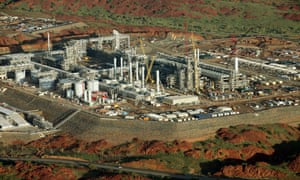Extract from The Guardian
Western Australian Browse project could emit more than 200m tonnes of CO2
Oil and gas giant Woodside Petroleum has applied for environmental
approval to build one of Australia’s biggest emitting industrial
developments – a liquefied natural gas (LNG) plant 425km north of Broome
– without a plan to reduce or offset its greenhouse gas pollution.
Documents submitted to the federal government for the long-mooted $28bn Browse LNG project show the offshore part of the development alone is expected to emit up to 200m tonnes of carbon dioxide over 50 years, peaking at 7m tonnes a year.
The total pollution from the Browse development could be significantly higher once processing the gas for export – usually the most emissions-intensive part of LNG projects – at an existing plant at Karratha is factored in, though Woodside has flagged it is considering running that plant on renewable energy.
Browse would involve pumping gas about 900km from offshore reservoirs
to the Pilbara to produce 10m tonnes of LNG a year, continuing an
industry boom that has seen production triple since 2012.Documents submitted to the federal government for the long-mooted $28bn Browse LNG project show the offshore part of the development alone is expected to emit up to 200m tonnes of carbon dioxide over 50 years, peaking at 7m tonnes a year.
The total pollution from the Browse development could be significantly higher once processing the gas for export – usually the most emissions-intensive part of LNG projects – at an existing plant at Karratha is factored in, though Woodside has flagged it is considering running that plant on renewable energy.
Government analysis expects the LNG industry is expected to reach a value of $48bn by 2020. It also shows the industry has been the main driver of the recent rise in national emissions. Researchers at Climate Analytics say the growth in LNG over the five years to 2020 is expected to effectively cancel out emissions avoided through the national renewable energy target.
Woodside says it is evaluating options to manage emissions from Browse and would comply with national emissions-reporting legislation and the safeguard mechanism, under which companies can nominate their own emissions limits based on future projections.
“While we are still in the early stages of the environmental approvals process, our position on offsets and emissions reductions is under consideration and will be outlined at an appropriate time,” a company spokeswoman said.
Piers Verstegen, director of the Conservation Council of Western Australia, said the Browse proposal would be particularly emissions-intensive due to the inflated carbon dioxide content of the reservoir and the energy required to pump the gas.
He said if the project was to go ahead it should have to offset all related emissions, both those in Australia and overseas. But he believed it was irresponsible to approve new fossil fuel developments as they were not consistent with global commitments to tackle climate change. He said offsets should be reserved for existing projects, not to enable new ones.
“It’s incredible to think the state government would consider a further expansion of what is an incredibly dirty source of gas at a time when the federal Labor party is proposing ambitious climate targets,” he said. “Fracking and LNG developments are going to put those targets out of reach.”
Woodside expects federal and state approval processes for the Browse development are likely to take about 18 months. It says gas developments help cut emissions.
The company’s chief executive, Peter Coleman, recently called for a national carbon price to help Australia meet emissions targets and encourage renewable energy. He said investors were increasingly concerned about the company’s sustainability measures.
The energy minister, Angus Taylor, dismissed Woodside’s call as “big business talking their own book” on the grounds a carbon price could help gas compete with coal.
Offsets investigation
The Browse proposal comes as Woodside is being audited by the WA government after it tried to sell carbon credits that it created under a state requirement to offset emissions from its Pluto LNG project.Pluto was approved on the condition Woodside would offset the CO2 released from the reservoir during gas extraction – 5.1m tonnes over the life of the operation, or about 15% of total emissions from the project. The company creates offsets by paying for tree planting in WA and New South Wales.
As revealed by the Footprint news website, a Woodside carbon disclosure report said the company attempted to sell some carbon credits created through its offset investments to the federal government via its emissions reduction fund, the main plank of the Direct Action policy. It raised the question of whether it would have led to the offsets being double-counted – once under a mandatory state obligation and a second time to generate revenue through the federal government fund.
Woodside’s spokeswoman denied this. She said the company unsuccessfully bid into the emissions reduction fund, in 2015, when it had enough credits to both meet its state obligation and take part in the federal emissions scheme.
WA’s environment minister, Stephen Dawson, said the state Department of Water and Environmental Regulation was auditing the company’s annual compliance report to determine whether it complied with a ministerial statement covering the project.
The issue is complicated by the ministerial statement having been issued in December 2007, before the introduction of national carbon credit laws and the emissions reduction fund.
Dawson said the statement does not explicitly address how carbon credits should be dealt with. “The treatment of any relevant carbon credits will be captured as part of the current audit,” he said.
A department spokeswoman said the audit was expected to be finished by February, but the results would not be made public.

No comments:
Post a Comment